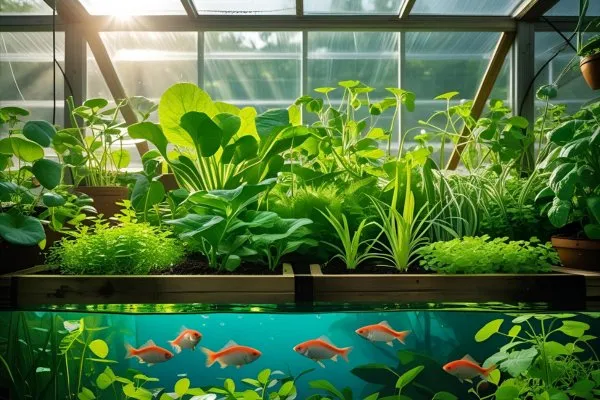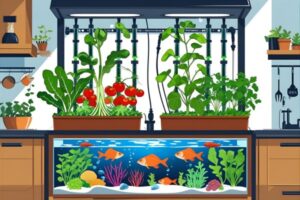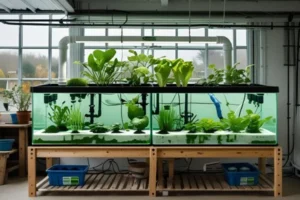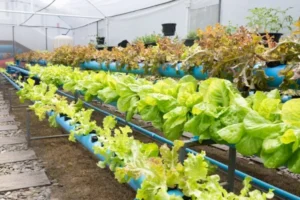What Is an Aquaponic Garden and Why Should You Start One?
An aquaponic garden is a revolutionary food production system that combines aquaculture (fish farming) with hydroponics (soilless plant cultivation) in a symbiotic environment. In this closed loop ecosystem, fish waste provides natural fertilizer for plants, while plants filter and purify the water for fish – creating a perfectly balanced, sustainable cycle that mimics nature.
The environmental benefits are extraordinary: Traditional agriculture uses approximately 80% of global freshwater resources, while aquaponic gardens use 90% less water than conventional farming. Your system recirculates the same 100 to 500 gallons of water continuously, losing only 1% to 2% weekly through evaporation and plant transpiration.
Economically, the advantages are compelling: A family of four spends an average of 4,500 dollars annually on fresh produce. A well managed 200 gallon aquaponic garden can produce 2,000 dollars to $3,000 dollars worth of organic vegetables and fish yearly, paying for itself within 8 to 12 months while providing chemical free food.
Perfect for modern living: Whether you have a 4 feet by 8 feet balcony, a basement corner, or a small backyard, aquaponic gardens adapt to spaces as small as 10 square feet. Urban dwellers in apartments across New York, London, and Toronto successfully operate countertop systems measuring just 24 inches by 16 inches, growing fresh herbs and leafy greens year round regardless of climate or season.
Essential Components of a Successful Aquaponic Garden System
Building a successful aquaponic garden requires four critical components working in perfect harmony. Understanding each element ensures your system thrives from day one.
Fish Tank Specifications and Sizing
Your fish tank serves as the heart of the system. For beginners, a 55 gallon to 100 gallon tank provides adequate space for 15 to 25 fish while maintaining stable water parameters. The tank should measure at least 4 feet in length and 2 feet in width to allow proper fish movement. Food grade plastic, fiberglass, or glass tanks work best, avoiding metal containers that can leach harmful chemicals.
Growing Beds and Media Selection
Growing beds should maintain a 1:1 ratio with your fish tank volume. A 100 gallon fish tank requires 100 gallons of growing bed space for optimal nutrient balance. Beds should be 12 inches deep to accommodate root systems and biological filtration. Expanded clay pebbles, measuring 8mm to 16mm in diameter, provide excellent drainage and surface area for beneficial bacteria. Gravel beds require 3/8 inch to 3/4 inch clean stones for proper water flow.
Pump and Plumbing Requirements
Your water pump must circulate the entire system volume every 1 to 2 hours. A 500 gallon system needs a pump rated at 250 to 500 gallons per hour (GPH). Energy efficient pumps consume 15 to 45 watts, costing approximately 3 to 8 dollars monthly in electricity. Use 1 inch PVC pipes for main water lines and 3/4 inch pipes for distribution to prevent flow restrictions.
Biological Filtration Components
Beneficial bacteria colonies require 6 to 8 weeks to establish fully. These microscopic workers convert fish waste ammonia into plant available nitrates. Maintain water temperatures between 75°F to 82°F degrees Fahrenheit for optimal bacterial activity. Your biofilter surface area should provide 1 to 2 square feet per pound of fish to ensure complete waste processing.
Step-by-Step Guide to Building Your DIY Aquaponic Garden
Building your first aquaponic garden becomes manageable when broken into clear, actionable steps. This systematic approach ensures success while avoiding costly mistakes that plague 60% of first time builders.
Planning and Design Considerations
Start by selecting your location based on 6 to 8 hours of daily sunlight exposure. Indoor systems require LED grow lights consuming 25 to 40 watts per square foot of growing space. Budget 300 to 800 dollars for a basic 100 gallon system, including all components and initial supplies. Sketch your layout ensuring the fish tank sits 12 to 18 inches below growing beds for gravity fed drainage.
Assembly Process and Component Installation
Begin with your fish tank placement on a level surface capable of supporting 900 to 1,200 pounds when filled. Install the water pump in the lowest section of your fish tank, rated for continuous operation. Connect 1 inch PVC pipes from pump to growing bed inlets using flexible tubing for final connections. Create drainage systems with 2 inch pipes and standpipes adjustable between 10 to 12 inches height for water level control.
Fill growing beds with 40 to 60 pounds of expanded clay pebbles per 50 gallon bed volume. Rinse media thoroughly until water runs clear, typically requiring 15 to 30 minutes of continuous washing. Install 3/4 inch distribution pipes with holes drilled every 6 inches for even water distribution across bed surfaces.
Initial Setup and Testing Procedures
Fill your system with dechlorinated water, allowing chlorine to evaporate for 24 to 48 hours before adding fish. Test your pump flow rate targeting 1 full system turnover every 60 to 90 minutes. Adjust standpipe heights to maintain 10 inches of water depth in growing beds during flood cycles.
System Cycling and Biological Establishment
The nitrogen cycle establishment requires 4 to 6 weeks of patience and monitoring. Add 5 to 10 hardy fish initially, feeding them 1% to 2% of their body weight daily. Monitor ammonia levels expecting spikes of 2 to 4 ppm during weeks 2 to 3, followed by nitrite peaks of 1 to 3 ppm. Once both ammonia and nitrites read 0 ppm consistently for 1 week, your system is ready for full stocking and planting.
Water temperature should remain stable between 70°F to 78°F degrees Fahrenheit throughout the cycling process for optimal bacterial growth.
Best Fish Species for Your Aquaponic Garden
Selecting the right fish species determines your system’s success, productivity, and maintenance requirements. These proven species offer reliable performance for both novice and experienced aquaponic gardeners.
Tilapia: The Gold Standard for Production
Tilapia remains the most popular choice for aquaponic systems due to exceptional hardiness and rapid growth rates. These resilient fish tolerate temperature fluctuations between 60°F to 85°F degrees Fahrenheit while thriving in pH levels from 6.5 to 8.5 units. Adult tilapia reach 1 to 2 pounds in 6 to 9 months, providing excellent protein yields for families.
Stock 1 tilapia per 5 to 10 gallons of tank volume for optimal growth and water quality. Feed high quality pellets containing 28% to 32% protein at 2% to 3% of total fish weight daily. Tilapia reproduction occurs naturally in systems, requiring separation of breeding pairs to prevent overcrowding. These fish consume 1.5 to 2.0 pounds of feed per 1 pound of weight gain.
Goldfish and Koi: Perfect for Beginners
Goldfish and koi offer ideal starter fish for new aquaponic gardeners, tolerating beginner mistakes while establishing biological systems. These ornamental species survive temperatures from 35°F to 80°F degrees Fahrenheit and adapt to pH ranges between 6.0 to 8.0 units. Stock 1 goldfish per 20 gallons or 1 koi per 50 gallons for proper space allocation.
Trout: Cool Climate Champions
Rainbow trout excel in cool weather systems, preferring water temperatures between 50°F to 65°F degrees Fahrenheit. These fish require high dissolved oxygen levels of 6 to 8 ppm and grow rapidly on 40% to 45% protein feeds. Trout reach market size of 10 to 12 ounces in 12 to 18 months under optimal conditions.
Catfish: Hardy and Productive Options
Channel catfish demonstrate remarkable hardiness, surviving in temperatures from 45°F to 85°F degrees Fahrenheit while tolerating poor water quality conditions. Stock 1 catfish per 8 to 12 gallons, feeding 28% to 32% protein pellets. These bottom feeders clean tank debris while producing excellent fertilizer for plant growth.
Top Vegetables and Herbs to Grow in Your Aquaponic Garden
Plant selection dramatically impacts your aquaponic garden’s productivity and success rate. These proven varieties deliver consistent harvests while thriving in nutrient rich aquaponic environments.
Leafy Greens: Maximum Production Champions
Lettuce varieties offer the highest success rates for beginning aquaponic gardeners, reaching harvest size in just 28 to 45 days from seed. Buttercrunch and romaine lettuce produce heads weighing 8 to 12 ounces each, yielding 2 to 3 pounds per square foot annually. Plant spacing of 6 to 8 inches between seedlings ensures optimal growth and air circulation.
Spinach thrives in cooler conditions between 50°F to 70°F degrees Fahrenheit, producing multiple harvests through cut and come again methods. Harvest outer leaves when plants reach 4 to 6 inches tall, allowing centers to continue growing for 60 to 90 days of continuous production.
Kale demonstrates exceptional cold tolerance and nutrient density, producing 12 to 18 ounce plants in 55 to 75 days. Varieties like Red Russian and Winterbor withstand temperatures down to 20°F degrees Fahrenheit while maintaining sweet flavors.
Herbs: High Value Aromatic Crops
Basil generates tremendous value in small spaces, with plants producing 2 to 4 ounces of fresh leaves weekly during peak growing season. Purple and Genovese varieties thrive in water temperatures between 65°F to 75°F degrees Fahrenheit. Regular pinching encourages bushy growth and prevents flowering for 4 to 6 months of continuous harvest.
Cilantro grows rapidly in cool conditions, reaching harvest height of 6 to 8 inches in 21 to 30 days. Succession plant every 2 to 3 weeks for continuous supply, as cilantro bolts quickly in temperatures above 75°F degrees Fahrenheit.
Fruiting Plants: Advanced Options for Experienced Growers
Cherry tomatoes succeed in established systems with mature biological filtration, requiring 60 to 80 days to first harvest. Indeterminate varieties produce 3 to 5 pounds per plant over 120 to 150 day growing seasons. Support structures must handle 15 to 25 pounds per plant at full maturity.
Hot peppers like jalapeños and serranos adapt well to aquaponic conditions, producing 50 to 100 peppers per plant annually.
Maintaining Water Quality in Your Aquaponic Garden
Water quality management determines the difference between thriving aquaponic gardens and complete system failures. Consistent monitoring and proactive adjustments ensure healthy fish, robust plant growth, and optimal nutrient cycling.
pH Management and Stabilization
Maintain pH levels between 6.8 to 7.2 units for optimal system performance, balancing fish health with plant nutrient uptake. Test pH daily during the first 60 days, then weekly once systems stabilize. Natural pH tends to decrease over time due to biological processes, dropping 0.1 to 0.3 units weekly in active systems.
Raise pH using potassium hydroxide at 1 teaspoon per 100 gallons of water, increasing levels by 0.2 to 0.4 units per treatment. Lower pH with phosphoric acid at 1 milliliter per 100 gallons, decreasing levels by 0.3 to 0.5 units safely. Always dilute chemicals in separate containers before adding to your system.
Nitrogen Cycle Monitoring and Management
Test ammonia levels twice weekly, maintaining readings below 1.0 ppm for fish safety. Healthy systems convert ammonia to nitrites within 24 to 48 hours, with nitrite levels remaining under 0.5 ppm continuously. Nitrate concentrations should range from 20 to 40 ppm, providing optimal plant nutrition without toxicity concerns.
Ammonia spikes above 2.0 ppm indicate overfeeding or inadequate biological filtration. Reduce feeding by 50% and increase aeration until levels stabilize below 1.0 ppm within 3 to 5 days.
Temperature Control and Dissolved Oxygen
Maintain water temperatures between 72°F to 78°F degrees Fahrenheit for year round production in most climates. Install aquarium heaters rated at 5 watts per gallon for consistent temperature control during cold seasons. Monitor dissolved oxygen levels above 5.0 ppm using air stones or venturi valves for continuous aeration.
Testing Schedule and Record Keeping
Establish testing routines measuring pH, ammonia, nitrites, and nitrates weekly. Record results in log books tracking trends and identifying potential problems before they impact fish or plant health. Digital pH meters provide accuracy within 0.1 units, while test strips offer quick field measurements for daily monitoring.
Common Aquaponic Garden Problems and Solutions
Even experienced aquaponic gardeners encounter challenges that can threaten system stability. Understanding these common issues and their proven solutions saves both time and money while protecting your investment.
Cloudy Water Issues and Bacterial Blooms
Cloudy water typically indicates bacterial imbalances or overfeeding practices affecting water clarity. Green water suggests algae blooms caused by excess nutrients and direct sunlight exposure for more than 6 to 8 hours daily. Brown or gray cloudiness points to bacterial blooms from decomposing organic matter or insufficient biological filtration.
Solution: Reduce feeding by 50% for 5 to 7 days while increasing aeration and water circulation. Install UV sterilizers rated at 8 to 10 watts per 100 gallons to eliminate harmful bacteria and algae spores. Cover fish tanks with black plastic or shade cloth blocking 70% to 80% of sunlight while maintaining plant lighting requirements.
Plant Nutrient Deficiencies and Yellowing
Yellow leaves with green veins indicate iron deficiency, common in systems with pH levels above 7.5 units. Purple leaf undersides suggest phosphorus shortages, while brown leaf edges indicate potassium deficiencies. These problems typically emerge 8 to 12 weeks after system startup.
Solution: Add chelated iron at 2 ppm concentration for iron deficiencies, testing levels weekly until plants recover. Supplement potassium using potassium hydroxide at 10 to 20 ppm dosages. Maintain pH between 6.8 to 7.2 units for optimal nutrient availability and absorption rates.
Fish Health Problems and Stress Indicators
Gasping at water surface indicates low dissolved oxygen below 4.0 ppm or high ammonia levels above 2.0 ppm. Lethargic behavior and loss of appetite suggest temperature stress, disease, or poor water quality conditions. White spots on fins indicate ich parasite infections requiring immediate treatment.
Solution: Increase aeration capacity by 50% and test water parameters immediately. Maintain water temperatures within species optimal ranges and dissolved oxygen above 6.0 ppm continuously. Treat ich with aquarium salt at 1 to 3 tablespoons per 5 gallons, raising temperatures 2°F to 4°F degrees Fahrenheit above normal for 10 to 14 days.
Cost Analysis: Building vs. Buying an Aquaponic Garden Kit
Financial considerations significantly impact your aquaponic garden decision, with DIY builds and commercial kits offering distinct advantages depending on your budget, skills, and time availability.
DIY System Cost Breakdown and Savings
Building your own 100 gallon aquaponic system costs approximately 300 to 500 dollars in materials, representing 60% to 70% savings compared to equivalent commercial kits. Essential components include fish tanks at 80 to 120 dollars, water pumps at 40 to 80 dollars, and plumbing materials at 60 to 100 dollars.
Growing media costs 50 to 80 dollars for expanded clay pebbles, while basic tools and miscellaneous supplies add 70 to 120 dollars to total expenses. Labor investment requires 15 to 25 hours of assembly time over 2 to 3 weekends for beginners following detailed plans.
Commercial Kit Pricing and Convenience Factors
Complete aquaponic kits range from 800 to 2,500 dollars for systems producing equivalent yields to DIY builds. Premium manufacturers like AquaSprouts and Back to the Roots charge 1,200 to 1,800 dollars for 100 gallon capacity systems including all components, instructions, and customer support.
Kits eliminate planning time, sourcing challenges, and compatibility issues while providing warranties lasting 1 to 3 years. Professional assembly services add 200 to 400 dollars but ensure proper installation and initial system cycling guidance.
Long-term Value and Return on Investment
Both approaches generate similar returns, producing 1,500 to 2,500 dollars worth of organic vegetables and fish annually from properly managed systems. DIY builds achieve payback periods of 6 to 10 months, while commercial kits require 8 to 15 months for full cost recovery.
Hidden Costs and Ongoing Expenses
Factor additional expenses including fish stock at 30 to 60 dollars, seeds and seedlings at 50 to 100 dollars annually, and fish food at 80 to 120 dollars yearly. Electricity costs range from 15 to 35 dollars monthly for pumps, heaters, and lighting systems. Water testing supplies add 40 to 80 dollars annually for proper system monitoring and maintenance.
Conclusion: Your Journey to Sustainable Food Production Starts Now
Starting your aquaponic garden represents more than growing food – it symbolizes a commitment to sustainable living, food security, and environmental stewardship that benefits both your family and planet.
Recap of Key Benefits and Opportunities
Aquaponic gardens deliver remarkable value, producing 8 to 10 times more vegetables per square foot compared to traditional soil gardening while using 90% less water. Your system generates fresh fish protein and organic vegetables year round, eliminating pesticides and reducing grocery costs by 1,500 to 2,500 dollars annually.
The knowledge gained through hands on experience creates lasting skills applicable to food production, water conservation, and sustainable agriculture practices. Children develop deeper connections to food sources while learning biology, chemistry, and environmental science through practical application.
Future Potential and Expansion Possibilities
Success with your first system opens doors to larger installations, community projects, and potential income streams through farmers markets or CSA programs. Advanced techniques like vertical growing, automation, and renewable energy integration multiply production capacity and efficiency gains.
Take Action Today
Begin your aquaponic journey by selecting your system size and location this week. Order essential components or choose a starter kit that matches your budget and skill level. Connect with local aquaponic communities through social media groups and workshops for ongoing support and inspiration.
Your sustainable food production adventure starts with a single step. The fish, plants, and beneficial bacteria await your commitment to creating something remarkable that feeds both body and soul for years to come.
Frequently Asked Questions About DIY Aquaponic Gardens
How much does it cost to start a DIY aquaponic garden?
A basic 100 gallon DIY aquaponic system costs 300 to 500 dollars in materials, plus 80 to 150 dollars for initial fish, plants, and supplies. Monthly operating costs range from 15 to 35 dollars for electricity, fish food, and testing supplies. Most gardeners recover their investment within 6 to 10 months through reduced grocery expenses.
How long before I can harvest vegetables and fish?
Leafy greens like lettuce and spinach reach harvest size in 28 to 45 days from planting. Herbs become ready for cutting in 21 to 30 days, while fruiting plants like tomatoes require 60 to 80 days to first harvest. Fish need 6 to 12 months to reach eating size, depending on species and desired weight.
How much daily maintenance does an aquaponic garden require?
Daily tasks require 5 to 10 minutes checking fish behavior, water levels, and plant health. Weekly maintenance includes 30 to 45 minutes testing water parameters, cleaning filters, and harvesting vegetables. Monthly deep cleaning and equipment inspection takes 1 to 2 hours for optimal system performance.
What happens if my fish die or plants fail?
Fish losses typically result from water quality issues, overfeeding, or temperature fluctuations. Replace fish gradually and address underlying causes before restocking. Plant failures often indicate nutrient deficiencies or pH imbalances correctable through water parameter adjustments and supplementation.
Can I grow aquaponic gardens indoors or during winter?
Indoor systems thrive with LED grow lights providing 14 to 16 hours of daily illumination. Winter growing requires aquarium heaters maintaining 70°F to 78°F degrees Fahrenheit water temperatures. Insulated greenhouses extend growing seasons in cold climates while reducing heating costs by 40% to 60% compared to heated indoor spaces.
Do aquaponic gardens smell or attract pests?
Properly maintained systems produce no offensive odors and actually improve air quality through plant oxygen production. Poor maintenance creates fish waste odors indicating water quality problems requiring immediate attention. Beneficial insects may visit flowering plants, but pest problems remain minimal compared to soil based gardens.



